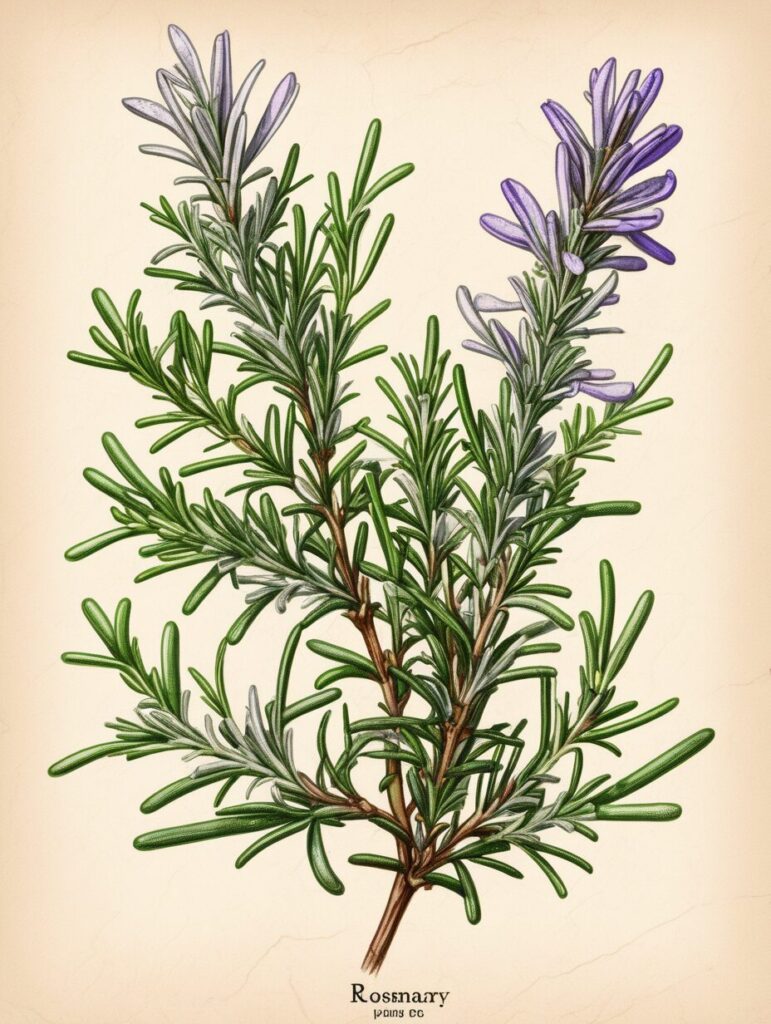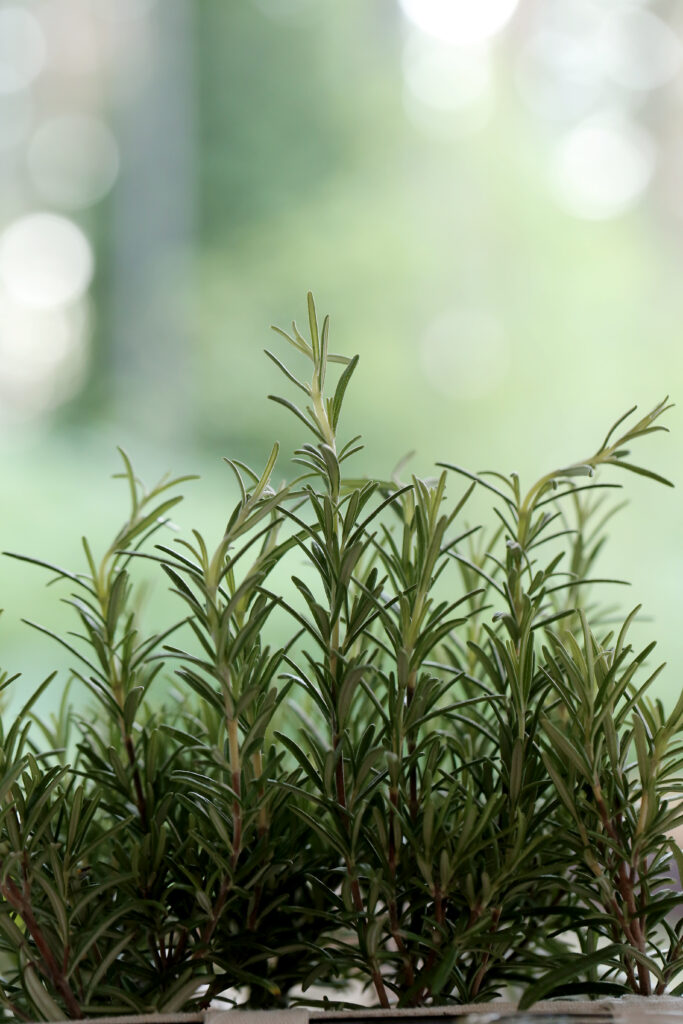Rosemary is a herb that has enchanted me since I first discovered its myriad qualities, both as a healing agent and as a muse for my most contemplative moments. There is something timeless and alluring about rosemary—a green, woody shrub with needle-like leaves and delicate blue flowers that carries with it centuries of lore, healing, and mystery. Its story is woven deep into the fabric of human history, a legacy as rich and complex as the fragrant essential oils it produces. I have always felt that rosemary represents the wanderer, the poet, the queen of contradiction. Its fabled origins and storied past make it more than just an herb; it is an invitation to remember, to heal, and to cherish the simple yet profound gifts of nature. One of the most captivating legends associated with rosemary is that of Hungary water, also known as the “Queen of Hungary’s Water.” According to lore, in the early fourteenth century, Queen Elizabeth of Hungary—suffering from the persistent torments of rheumatism and gout—received a miraculous herbal tonic from a wandering hermit. This tonic was prepared by distilling fresh rosemary with alcohol, and it was said to have restored her vitality, alleviated her pain, and even granted her such a youthful radiance that, at the age of seventy, the King of Poland was smitten and asked for her hand in marriage. The tale of Hungary water quickly spread throughout medieval Europe, becoming a fixture in the gilded courts as a perfume, a medicinal remedy, and an occasional cocktail ingredient. In this way, rosemary was revered not only for its flavor and fragrance but also as a symbol of healing and beauty.
The significance of rosemary extends further back than that, with ancient scholars and physicians such as Pliny the Elder, Dioscorides, and Galen all extolling its virtues in their treatises on medicinal plants. Dioscorides included rosemary in his classic work, “De Materia Medica,” which served as a foundational text on herbal medicine for over a millennium. By the time rosemary was being cultivated in Spain in the thirteenth century, it had already been established as a remedy for a host of ailments. It later earned a place as a staple seasoning for preserved meats from the fifteenth through the eighteenth centuries, which only deepened its association with both nourishment and longevity. Rosemary’s rich history is further celebrated in wedding traditions, where brides would craft wreaths from its branches—often dipped in fragrant waters—as symbols of fidelity, love, and the memory of their past. Such customs even found their way into royal unions; for instance, Anne of Cleves is said to have worn a rosemary wreath at her wedding, and guests were sometimes given gilded rosemary branches as tokens of goodwill. The lines of English poet Robert Herrick, who mused that rosemary was for remembrance, have long echoed in the halls of love and loss, reinforcing the herb’s poetic reputation as a guardian of memory.



There is even a curious twist in rosemary’s folklore that speaks of its unexpected role in crime prevention. An odd tradition from the fourteenth century claimed that washing a thief’s feet with a concoction of rosemary root and wine vinegar would strip them of the will to commit further crimes. Although the logistics of such a practice seem almost comically impractical—it is hard to imagine how one might persuade a thief to undergo such an ordeal—it nonetheless highlights the deep cultural impact rosemary had on people, who believed so fervently in the healing and transformative power of the herb. Another beloved legend tells of the mysterious origins of rosemary’s blue flowers. It is said that, until one day, when the Virgin Mary laid out her freshly washed blue dress to dry, rosemary bore only white flowers. The contact with the blue fabric changed its color forever, and rosemary’s blossoms have been blue ever since. Regardless of whether one subscribes to this tale, it is clear that the name “rosemary” (rosmarinus in Latin) does not derive from “Mary’s rose” but from the words for dew and the sea, evoking an image of delicate droplets of dew that glisten on its leaves like tiny strands of seawater.
In my own life, rosemary has always been a constant companion—a herb embraced by the kitchens of noblewomen and the apothecaries of humble healers alike. Over the centuries, its presence in wedding traditions and even in the rituals of memory enhancement has been well documented. Greek scholars reputedly adorned their hair with sprigs of rosemary to sharpen their memory during exams; its role as the “herb of remembrance” is echoed by Shakespeare’s use of the phrase in Hamlet. Such associations cement rosemary’s place as a symbol of longevity, wisdom, and unwavering beauty. It is a reminder that nature’s gifts are not only functional but also symbolic, intertwining our daily lives with the timeless echoes of the past.
Rosemary’s medicinal properties are as fascinating as its history. As a woody, evergreen shrub, rosemary is celebrated for its ability to enhance digestion, stimulate circulation, and serve as a cognitive booster (increase memory). Its earthy, pine-like aroma and slightly bitter, astringent taste provide layers of flavor that can enhance savory dishes, especially those featuring meats like lamb or poultry, and even hearty vegetable stews. But beyond its culinary uses, rosemary is a treasure trove of bioactive compounds, notably rosmarinic acid, carnosic acid, and 1,8-cineole. Rosmarinic acid, which is found in high concentrations in rosemary, is an antioxidant par excellence. It neutralizes free radicals, reduces inflammation, and even exhibits antimicrobial properties, making it a natural defender against cellular stress and microbial invaders. Carnosic acid further supports these antioxidant and anti-inflammatory activities, while 1,8-cineole, responsible for the herb’s distinctive aroma, has been linked to enhanced cognitive function, possibly by improving focus and memory as it crosses the blood-brain barrier. These compounds not only contribute to rosemary’s effectiveness as a natural remedy but also underscore its role in traditional herbal medicine as a potent, multi-functional treatment for a swath of ailments ranging from digestive disturbances to respiratory issues.
I have often turned to rosemary when I need a gentle lift—a herbal companion that steadies the mind and fortifies the spirit. Its pleasant yet invigorating aroma has a way of clearing my thoughts and easing stress. When I am feeling overwhelmed or foggy, I sometimes find solace simply by inhaling a sprig of fresh rosemary, or by infusing it in hot water to make a soothing tea. In one particularly memorable instance, during a period of intense stress at work, I steeped a few rosemary sprigs in boiling water, and as I sipped the resulting tea, I felt a wave of calm wash over me. It was as if the very essence of rosemary had reached into my mind and smoothed away the jagged edges of anxiety. Such experiences have deepened my trust in the herb as a natural ally in the face of life’s inevitable challenges.
The use of rosemary is not confined solely to internal use; it extends to the external realms as well. Its essential oil is a popular ingredient in aromatherapy, where it is used to reduce cortisol levels and mitigate the harmful effects of stress. Many people spray diluted rosemary oil in their living spaces or apply it to their temples and wrists to invite clarity and calm into their day. There is even evidence that simply inhaling the aroma of rosemary essential oil can enhance cognitive performance, a benefit attributed in part to its stimulating effects on the brain’s neural pathways. This connection between aroma and cognitive function is one of the many ways in which rosemary exemplifies the intertwining of nature, medicine, and daily ritual.
Moreover, rosemary’s healing touch extends to the care of our skin and hair. Its antimicrobial and anti-inflammatory properties make it an excellent addition to natural skincare routines. I have often used rosemary-infused water as a facial rinse to combat mild acne and to soothe irritated skin. Additionally, rosemary tea, with its high antioxidant content, can be used as a hair rinse to invigorate the scalp and encourage a healthy shine. There is something almost ritualistic about the act of preparing these natural infusions—whether they are for the body or for the spirit—and in each case, rosemary stands out as a symbol of natural fortitude and resilience.
Culinary lore aside, I find that rosemary’s practical aspects in the garden are just as profound as its historical and medicinal uses. Rosemary is a member of the Lamiaceae family, traditionally classified as Rosmarinus officinalis, though recent taxonomic revisions have placed it in the Salvia genus as Salvia rosmarinus. Its name, deriving from the Latin “ros marinus,” evokes the image of dew of the sea, a poetic nod to its coastal origins and the sparkling droplets that adorn its leaves in the morning light. This connection to water, life, and renewal makes rosemary not only a robust culinary herb but also a steadfast companion in any garden setting. It thrives in well-drained soil and full sun, preferring a slightly alkaline environment and minimal watering once established. I have always appreciated how easily rosemary adapts to diverse conditions, making it a hearty, low-maintenance addition to outdoor spaces that rewards the dedicated gardener with its persistent beauty. Its woody stems and silvery-green leaves have a way of lending an air of refined simplicity to the garden, a quiet presence that contrasts yet complements the lush vibrancy of other, more delicate herbs.
The historical appeal of rosemary is vast and multi-layered. Throughout the ages, it has been a symbol of remembrance and fidelity, often used in wedding ceremonies to invoke lasting love and memory. In ancient Greece, students would wear sprigs of rosemary to boost their memory during exams, and such traditions have persisted in various forms in modern culture. Shakespeare immortalized rosemary in his plays, most notably when Ophelia admonished, “There’s rosemary, that’s for remembrance; pray you, love, remember!” This invocation of rosemary as a remedy for forgetfulness has resonated with generations, cementing its reputation as an herb that holds the promise of mindfulness and cognitive clarity. Its presence in ceremonies of love and loss, in both weddings and funerals, speaks to an enduring belief that rosemary can bridge the gap between memory and identity, between what is transient and what is eternal.
In the realm of science, rosemary’s benefits are equally impressive. The herb’s polyphenolic compounds, including rosmarinic acid and carnosic acid, act as powerful antioxidants that help protect the body from oxidative stress and inflammation. These compounds also contribute to rosemary’s antimicrobial properties, making it effective against certain pathogens while being gentle enough to support the balance of the human microbiota. There is a fascinating interplay between rosemary and the human body’s microbial communities. In the gut, for example, the bioactive compounds in rosemary may help foster a balanced microbial ecosystem by selectively inhibiting harmful bacteria while promoting the growth of beneficial strains such as Lactobacilli and Bifidobacteria. This prebiotic effect is essential for maintaining overall digestive health and supporting the immune system. The same antimicrobial mechanisms at play on the skin hint at rosemary’s potential for supporting dermatological health as well, where its compounds assist in maintaining a harmonious balance of the skin microbiome.
I have always admired how rosemary seems to embody the spirit of resilience, wisdom, and revival. It is an herb that speaks to me on many levels, from its storied past in the annals of herbal medicine to its practical applications on the kitchen counter and in the garden. Its use in traditional remedies—as a digestive aid, a remedy for respiratory discomfort, and a healer of wounds—brings to mind the words of ancient herbalists who saw in rosemary a living testament to nature’s capacity for restoration. Today, modern research continues to explore the many pharmacological activities of rosemary, from cognitive stimulation to anti-inflammatory and antidiabetic effects. Its ability to mimic insulin pathways and enhance the uptake of glucose into muscle cells, for instance, offers promising avenues for the management of hyperglycemia as observed in diabetes. And yet, beyond all the scientific details and clinical studies, there remains an almost ineffable quality to rosemary—a fragrance that conjures memories of sunlit Mediterranean groves, a flavor that infuses dishes with a quiet, invigorating zest, and an energy that seems to capture the very essence of vitality itself.
For me, rosemary is like a faithful friend who has journeyed with me through many chapters of life—a reminder of the simple, enduring power of nature to heal, nurture, and inspire. Whether I am savoring its aromatic taste in a savory roast, inhaling its crisp, pine-like scent to clear my mind, or admiring the silver-green shimmer of its leaves in the morning light, it never fails to fill me with a profound sense of gratitude. The lore that surrounds rosemary, from its crucial role in Hungary water to its symbolic use in wedding traditions and its mythic origins in ancient perfumery, all serve to enhance its allure. It is a plant that carries the wisdom of the ages, a timeless companion whose benefits extend far beyond the realm of the ordinary.
In the quiet moments when I sit in my garden, tending to my herbs and feeling the earth between my fingers, I am often reminded that creating a sanctuary—whether within a garden or within one’s own heart—requires dedication, perseverance, and a deep respect for the natural cycles of growth. Rosemary, with its robust, healing presence, embodies all of these qualities. It is a gentle guide that has taught me the importance of nurturing both my external surroundings and the internal spaces of my mind and body. Its lessons are simple yet profound: set aside time to care, to allow for slow growth, and to honor the journey even when results are not immediately visible. Such is the nature of true healing and transformation.
In keeping with this recognition of rosemary’s multifaceted benefits and storied past, I would like now to share a simple recipe that captures some of its most cherished qualities—a Calming Tincture that I have often turned to in times of stress and need for clarity. This tincture is a fragrant elixir meant to soothe the spirit and gently promote relaxation. To make the Calming Tincture, take 1/4 cup of dried rosemary leaves and 1/4 cup of dried lavender flowers. Place the dried herbs in a sterilized glass jar and carefully pour in 1 pint of high-proof grain alcohol or vodka, ensuring that the herbs are completely submerged. Seal the jar tightly, and give it a gentle shake to mix the contents well. Then, place the jar in a cool, dark place and allow the mixture to infuse for 4 to 6 weeks, shaking it every few days. Once the infusion period is complete, strain the tincture through a piece of cheesecloth or a fine mesh sieve into a clean bowl, pressing the herbs to extract as much liquid as possible. Transfer the strained tincture into amber dropper bottles for storage. Use a few drops under your tongue or mix them into a glass of water when seeking a moment of calm and relaxation. This tincture, with its blend of rosemary and lavender, encapsulates the quiet strength and healing power of these ancient herbs, offering a little drop of tranquility in the midst of life’s chaos.
Rosemary, in all its aromatic glory and storied tradition, remains a steadfast companion in my daily life—a herb that nourishes the body, enriches the mind, and restores the spirit. It is a reminder that true healing is a journey, one that unfolds slowly, with care and commitment. With each breath of its pine-like fragrance, I am transported to sunlit groves and ancient apothecaries, where the secrets of nature are whispered softly on the breeze. And in those moments when I need a gentle pause, a little moment of clarity, I reach for the calming tincture—a humble yet profound tribute to the enduring magic of rosemary.




